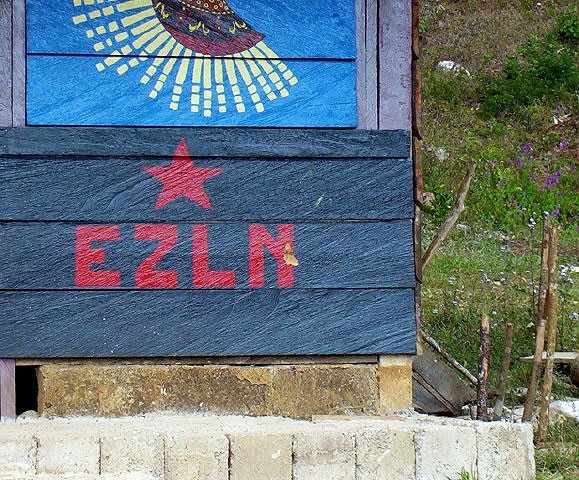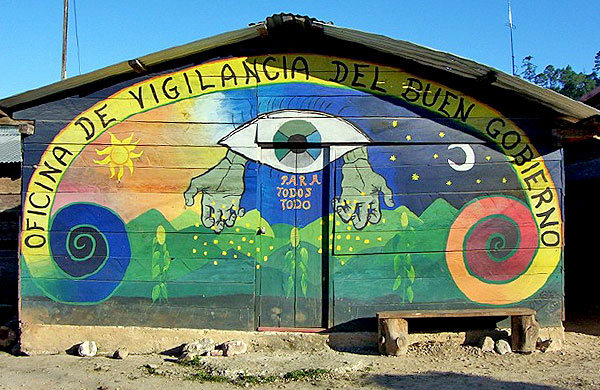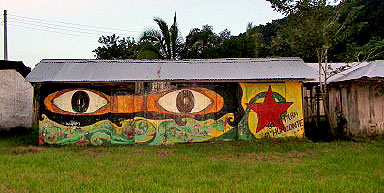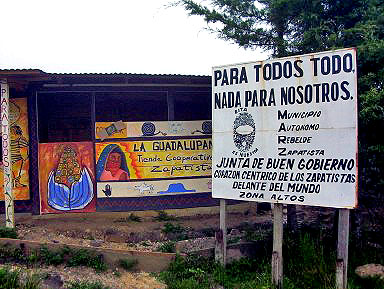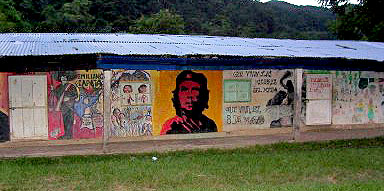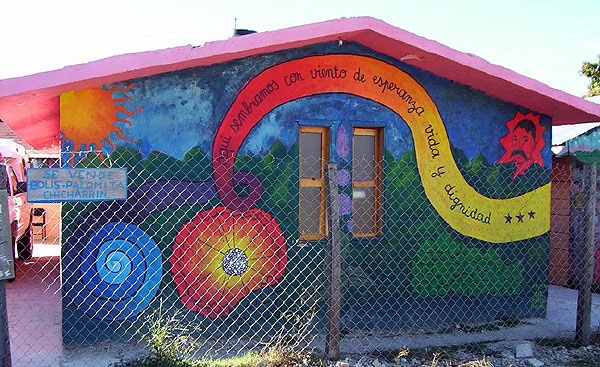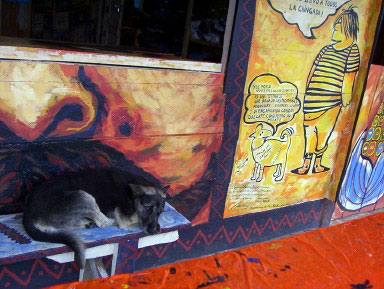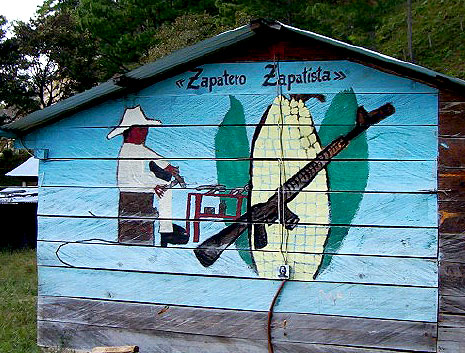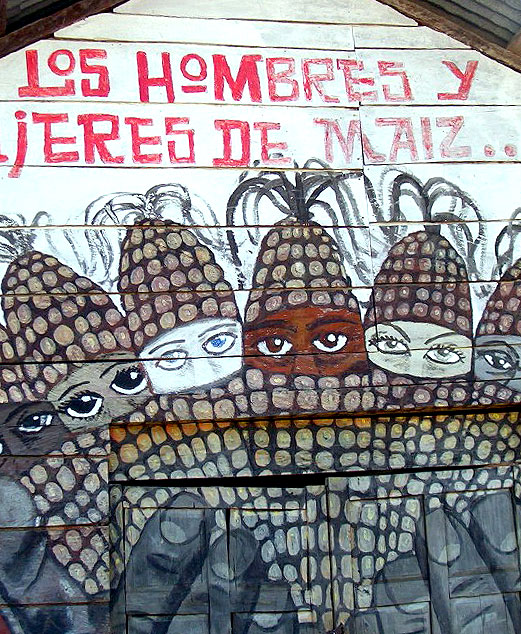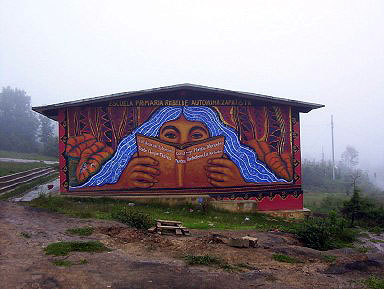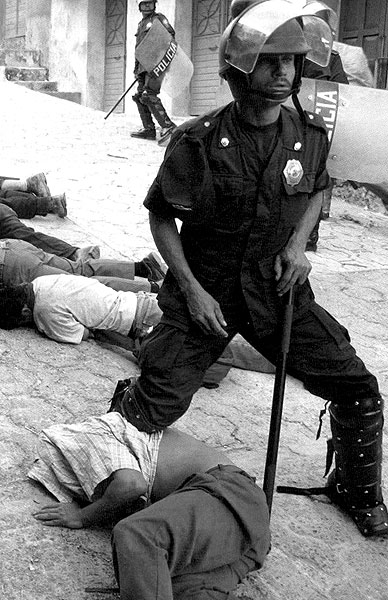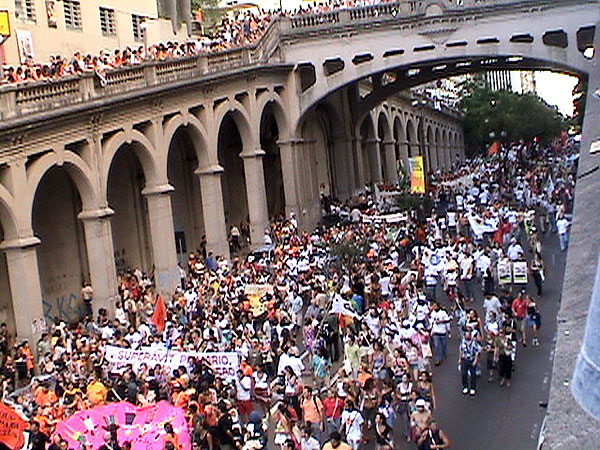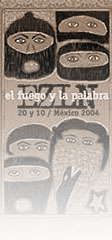
2004
03/01/2005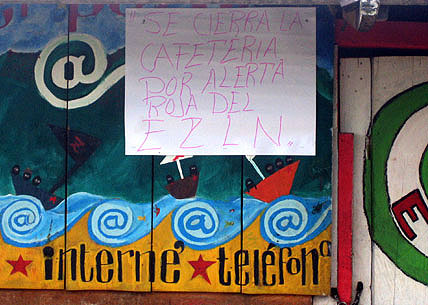
UPDATE: From the Red Alert to the Sixth Declaration of the Lacandon Jungle
29/07/2005![]() ‘Autonomy is the work. That the people have the choice to exercise their rights. It is a way of fighting, fair and sensible. Working on health care and other issues is a weapon of struggle that does not shoot bullets, but words, which are calling on humanity.’
‘Autonomy is the work. That the people have the choice to exercise their rights. It is a way of fighting, fair and sensible. Working on health care and other issues is a weapon of struggle that does not shoot bullets, but words, which are calling on humanity.’
(Junta de Buen Gobierno de Morelia – Council of Good Government of Morelia)
Traveling through Chiapas one comes across a number of signs reading: “You are in Zapatista Territory in rebellion. Here the people rule and the government obeys.” It means that you are going through a territory inhabited by civilian support bases of the Ejército Zapatista de Liberación Nacional (EZLN).
The Zapatista communities have organized themselves since 1994 in Zapatista Rebel Autonomous Municipalities (MAREZ), ruled by an Autonomous Council formed by representatives of the communities. The MAREZ overlap the constitutional municipalities both geographically and politically, and, as a parallel structure to official policy, they make their own educational, health and legal decisions. Resistance means not accepting government projects or money.
In 2001, a constitutional reform about indigenous rights and culture was passed, claiming by doing this to have complied with the San Andrés Accords. To the EZLN and the Indigenous National Congress (CNI), such reform perpetuates the State paternalism over the indigenous people, without recognizing their self-government. That is why they determined the construction of autonomy through the pragmatic way, considering the San Andrés Accords to be a valid law enforced in their territories.
In August 2003 the Zapatistas created the Juntas del Buen Gobierno (JBG) Councils of Good Government as a new level of their autonomous organization. The JBG are formed by the Autonomous Councils’ authorities, who switch every 7,15 or 30 days, depending on each region.
There are 5 Councils of Good Government whose headquarters are in the Caracoles, placed where the ‘Aguascalientes’ originally used to be and that were meeting points of civil society with the Zapatistas. The Caracoles are a symbolic representation of a direct open gate to the Zapatista autonomous life.
In all the Caracoles one can find houses decorated with faces of Zapata, of sub-commander Marcos, war martyrs or corns wearing balaclavas. In Oventik you can buy at the women’s craftsmanship cooperatives, or buy hammocks in Roberto Barrios . In La Garrucha you can find the ‘cyber pozol’ at the Smaliyel cafeteria. Both in La Realidad and in Morelia you can see movies at the diner-cafeterias. In all of them you will find the Civilian Peace Camps, built for human rights observers and movement supporters.
From the Caracoles, the Councils of Good Government talked to us about their autonomy, progress, constraints and challenges.
“Govern by obeying”
The Zapatista Caracols make visible the construction of the autonomy that the Zapatista support bases carried out even before 1994. Even further, they represent the “ways of living and working” that the indigenous peoples have practiced for centuries in order to culturally resist colonization and marginalization. “Our autonomy is something that has been in progress for many years and has been maintained with its own customs, forms of decision-making and its own language. It has been developing for a long time, because the ways of the indigenous do not coincide with the ways of the official government. And we decide on the way to “govern by obeying” with our own authorities so that they help us and that we also help ourselves; autonomy belongs to everyone (Council of Good Government, La Garrucha).
Zapatista autonomy is based on the right to elect its authorities under the principle of “govern by obeying.” “The idea of the communities is to govern themselves for themselves, basing their struggle in the principle that power is in the people. In our community, the people discuss for a while what we propose to the authorities. But, as authorities, we are only representatives. Above us there is a power: the power of the people. The people have problems that they do not always discuss; if they haven’t discussed an issue, it is simply their problem. But if we do something that the people do not know, then we are criticized. We have to accept this.” (Council of Good Government , La Realidad)
Autonomy does not happen only in the political sphere, but also in the cultural and economic ones. “Autonomy is done by practicing; for example, in the cornfields, with what the people are harvesting, they’re not going to use ‘gramoxon’ (pesticide) anymore. We know that chemicals are a poison for us. One part of what we are doing is changing over to the natural insecticide that is made in the cornfields, and people are using it. It is the people themselves who are using it because our ancestors never used chemicals. Autonomy is acted out in different ways; for us it means to stop depending on the government for anything, especially in products which affect us as indigenous peoples, like transgenics.” (Council of Good Government, Roberto Barrios)
The communities are building their own educational programs, health systems and forms of trade. They are seeking out a way to have greater self-sufficiency in regards to food, at a time in which the North American Free Trade Agreement (NAFTA) has limited the existence of fair markets for agricultural goods, such as coffee, corn or beans.
The process of autonomy is slow going, because, as they shared with us, ‘What has the most weight is the practical part. Talking is very easy, but doing is something else. Theory has a value, but it is not the most important thing.’ (Council of Good Government, Morelia)
Education
At the educational level, schools exist in almost all of the municipalities and they have indigenous educational promoters from the same communities. The promoters are trained in workshops, which are supported, either directly or through economical contributions, by the national and international civil society. In the region of Oventik, they started their autonomous educational system with a secondary school, to follow later with a primary school. The Caracol receives youngsters from the different municipalities, who stay there to study at the secondary school. In other regions, like in Morelia, each municipality has a primary and secondary school and they dream of having their own university. ‘We don’t want to have the same system nor compare the government’s education to ours, but their model doesn’t work for the indigenous peoples nor for the Zapatistas, that is why our schools have a different approach than that of the government. Theirs is individual and selfish; they prepare the student to serve the businessman so as not to lose the business pattern. They don’t teach about relationships with nature. Autonomous education helps the people and the organization because the children learn not to serve the boss but rather to put their knowledge at the service of everyone.’ (Council of Good Government, Morelia)
In Roberto Barrios, children start in an educational project called “Semillita del Sol” (Little Seed of the Sun) and then move to the Zapatista Autonomous Technical Cultural Center (CCTAZ), where students decide what area they want to dedicate themselves to. They prefer not to utilize the system of grades in their educational system, in contrast to the government schools, in order not to exclude any student and to allow each of them to advance according to his or her abilities.
The educational content in the schools is born of the communities’ needs. “The pedagogical-political method of our education is different; we don’t grab subjects as they do in regular schools. We created subject areas; in the area of Language, we group all of our languages together with Spanish. They also study ‘Histories’, so that all learn about the Zapatista struggle and the different struggles against those who oppress us. ‘Life and the Environment’ is studied too, which covers ‘life and natural resources.’ “ (Council of Good Government, La Garrucha)
In autonomous education and health, humanity and dignity are valued above money; recovering the sense of “collective good.” Education and health are essential to the Zapatista way of conceiving of the “good life” for all. ‘In our organization there is no vision of serving in exchange for money; work is born of the conscience.’ (Council of Good Government, Morelia)
The promoters are chosen by the community and they don’t receive a salary. As a result, one of the greatest challenges facing the autonomous educational system is preventing the desertion of promoters when communities are not able to provide them with enough support.
Health
Another great advance of the autonomous municipalities is in the area of health. There are regional clinics in Oventik and La Garrucha, and in the community of San José del Río, in the region of La Realidad, they have a hospital where they have practiced more than ten surgeries in their own operating room, thanks to the solidarity and support of doctors coming from Comitán.
Their aim is for each municipality to have a small drugstore and for each community to have health promoters who can take care of illnesses. The training of the promoters is similar to that which is provided in the educational programs. In the area of health they work to train the promoters in different specialties: gynecology, dentistry, laboratory work, pediatrics and herbal medicines. ‘The idea is that those who know medicinal plants are the elders. Young people don’t know what plants are for. Therefore we need to rescue this wisdom before they go six feet down. They prepared the elders to be the teachers. Some promoters are trained in chemical medicines and others in natural medicines.’ (Council of Government, La Realidad)
When there is enough medicine in the drugstores (from donations from civil society), those that are a part of the Zapatista support bases don’t pay for them. However, when there’s a shortage, they have to pay the cost of the medicine. The doctor’s visit is also free for those that form part of the support base. On the other hand, “non-Zapatistas” have to pay for the doctor’s visit and medications at cost. Many people from other organizations prefer to go to the Zapatista medical centers because promoters there speak their same language and they assist the sick respectfully. ‘Health is from humanity. There is a great and palpable problem with medicines and the attention to the sick. Women mainly are very afraid to go to hospitals. We are marginalized in official hospitals; these are not a dignified space for us.’ (Council of Good Government, Morelia)
In health programs, attention is being focused on the prevention of illness through the improvement of hygiene and nutrition. For this reason, in La Garrucha’s Caracol, they have put into effect a “holistic plan” which includes the construction of latrines, personal hygiene, the cultivation of vegetables and obtaining vaccinations. In Morelia, individual and collective health is addressed in the educational materials used in the autonomous school.
Economic Autonomy
During the last few years, autonomous municipalities have created abarrotes (small commercial centers) and cooperatives in order to generate finances for their ‘non-monetary’ projects (health and education) and in order to be more economically independent. ‘Speaking of trade, we already have developed work, as in the coffee cooperatives. The cooperatives export coffee at an international level (Mut Vitz, Yachil Xolojobal). We also have women’s artisan cooperatives: Mujeres por la Dignidad (Women for Dignity), Xiluchon and Niximrosa. In addition, we have a shoe workshop. They make all kinds of boots and shoes used by people. Collective tasks are done in the communities. Women, for example, work in the bread workshop, in the care of animals and in the vegetable gardens.
These are examples of the works that are done by both men and women so that our support bases can survive and, in this way, continue to maintain the resistance. We don’t worry much about crumbs from the government. We have our own work.’ (Council of Good Government, Oventik)
There is collective work, like cattle, coffee and the cornfields, but the most difficult challenge is how to market the products at fair prices. This year they managed to raise the price of coffee in the region of La Realidad, because the Caracol bought the coffee and transported it to Tapachula, where buyers paid more than the coyotes (middlemen who transport products for sale from rural areas to larger markets). ‘We began to think that, since we have the ‘Chómpiras’ (the region’s truck), we can do better in the sale of coffee. We hate the cheating coyotes. They pay 12.5 pesos per kilogram of coffee. In Tapachula, they pay up to 17 pesos per kilo. We began to do the calculations and, with our truck, we saw that we could pay our compañeros and also non-Zapatistas – up to 14.5 pesos per kilo. On the day we announced that, many people arrived here, and the others weren’t able buy. And then coyotes started to pay more than we did: 15 pesos per kilo. The important thing is that they pay more, but the compañeros know that what the Council of Good Government earns is going to be used for the benefit of the people. Coyotes stopped buying. The most difficult thing is the economic self-sufficiency.’ (Council of Good Government, La Realidad)
The challenge is to depend less on external products and developing their own production and self-consumption is a constant preoccupation in all of the autonomous regions. In Roberto Barrios, they have initiated the area of agro-ecology in order to diversify their crops and also to be able to market them. They are thinking about being able to exchange products with other regions.
It is still difficult to stop consuming products from transnational companies. ‘We have not been able to avoid it because our people lack the necessary level of awareness. Everyone craves it, and we get thirsty and drink Coca-cola and eat ‘Sabritas.’ Eventually we hope to be able to organize ourselves better to not consume these products. But doing so is very difficult. Little by little we’re seeing which things benefit the people and which ones don’t, but we are always going step by step. Our walking will say it. We don’t need to prohibit certain products, but instead raise awareness about them. It’s about a matter of training and information; the media and the information we receive have a great impact. The important thing is that the questions and the reflections are sparked and that they are grounded in action, because the most powerful thing is acting, doing. The Council of Good Government prohibiting something is not enough.’ (Council of Good Government, Morelia).
Justice
During this year of government, the principal conflicts we dealt with have been agrarian. The Councils of Good Government seek the mediation of the parties involved in order to transform conflicts: ‘We think and we believe that there is another way to apply justice, without money in between. The investigation is first; going to see the facts, we work a lot on conciliation, on mediation, on being neutral. After that, we call together the involved parties. We frequently work with the law of the uses and customs of communities. We know that there are also bad customs. The elders are very important for raising awareness. If someone stole something, we have to take a look at why he stole, because everyone is in need. We work with both parties. Then there is a sentencing and if the person recognizes what he has done, he does some collective work.’ (Good Government Council, Morelia)
In the border region (La Realidad), there are many problems with the trafficking of undocumented immigrants. At the time of our visit, they had detained a “pollero” (trafficker of migrants), since in the Zapatista territories, the trafficking of people, drugs, alcohol and arms is prohibited. The “pollero” was sanctioned by the Council of Good Government to work for six months on the construction of a bridge for the benefit of the communities so that he can reflect on his actions.
Non-Zapatistas also take their conflicts to the Councils of Good Government in order to resolve them there, since impunity and corruption still prevail in the official justice system. In one Council of Good Government they shared with us that one compañero from a non-Zapatista organization had received help from the municipal presidency for his travel to the Council of Good Government, showing us a copy of the citation from the Council.
Through their autonomy, the Zapatista communities are not only regenerating their culture by rescuing their languages, their methods of cultivation, and their own wisdom, but they are also attempting to make participatory democracy into a reality. Paradoxically, something so logical and reasonable becomes a struggle of resistance against a world that is adrift and in which the crying out by humanity represents opposing the “development” imposed by the capitalist world system. Zapatista autonomy is contributing to the creation of a crack in the structure of this world organization where capital is valued above human values and where the market prevails over ethics. The Zapatistas are showing a way, their way. They act, walk, and ask themselves. We, seated in front of them, cannot do anything else than look within ourselves and wonder: what are we doing to transform this world where inequity and violence are necessary to increase the richness of a few ones?

